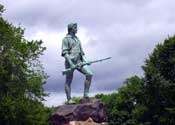Lexington - Massachusetts Historic Site

THE BATTLES OF LEXINGTON AND CONCORD
After several unpleasant episodes occurred with the colonists like the Boston Massacre and later the Boston Tea Party, Great Britain was prepared to go to all-out war. In mid-April 1775, Thomas Gage instructed light infantry and grenadiers to form near Boston under the command of Lieutenant Colonel Francis Smith. A Royal Marine- Major John Pitcairn was to lead an advance toward Lexington, Massachusetts. At 10 o’clock in the evening on April 18th, British officers roused their men for what was supposed to be a secret mission- but in 1775, nothing was secret in the city of Boston.
Local patriots led by Dr. Joseph Warren had learned of the plan. Warren instructed Boston silversmith Paul Revere to warn John Hancock and Samuel Adams of the Continental Congress of the planned maneuver. Riding on his horse late at night, he made it to his destination, later returning and stopping in Charlestown where he left word of the signals which would be used to notify citizens of the enemy advance. From the steeple of the Old North Church: one lantern would signify a land approach out over the strip called Boston Neck, two would indicate a seaward move if the British took to boats across Back Bay. The immortal poem by Henry Wadsworth Longfellow would centuries later be memorized by school children across the country:
“Listen, my children, and you shall hear
Of the midnight ride of Paul Revere,
On the eighteenth of April, in Seventy-five;
Hardly a man is now alive
Who remembers that famous day and year…”
Late at night, the British took boats over the Back Bay to Lechmere Point. When they landed on the opposite shore, some of them may have noticed two lanterns hanging in the steeple of North Church. At 4:30 a.m. in the first light of dawn, the troops came to the small crossroads town of 750 residents. About 70 local militia, nicknamed “Minutemen” for their ability to be ready on short notice were there led by Captain John Parker, ready for action. Seeing that their foe had a much smaller force, British commander Pitcairn simply instructed them to lay down their arms, not wanting to see bloodshed. Parker instructed his men to disperse and they did, slowly walking away. Yet Pitcairn insisted that they lay down their arms, with some of his troops beginning to yell and charge the colonists.
A shot rang out, but it is uncertain to this day who fired that fatal bullet. “The shot heard ‘round the world” is the way it was described in later years as Americans looked back on their uncertain beginnings fighting against the most powerful military force on Earth. The British fired several volleys, killing eight and wounding ten Minutemen, who finally dispersed up the road toward Concord. The British followed close behind, only to find when they reached the adjoining town that there were 400 militia waiting for them. The Americans fared slightly better here, instantly killing 12 Redcoats (including four officers) before their commander gave the order to retreat. With these two skirmishes, began the eight year long Revolutionary War.Today the battles are commemorated at the Minute Man National Historic Park 22 miles outside of Boston. The park has a visitor center along with a Battle Road Trail and access to Hartwell Tavern and the North Bridge.
